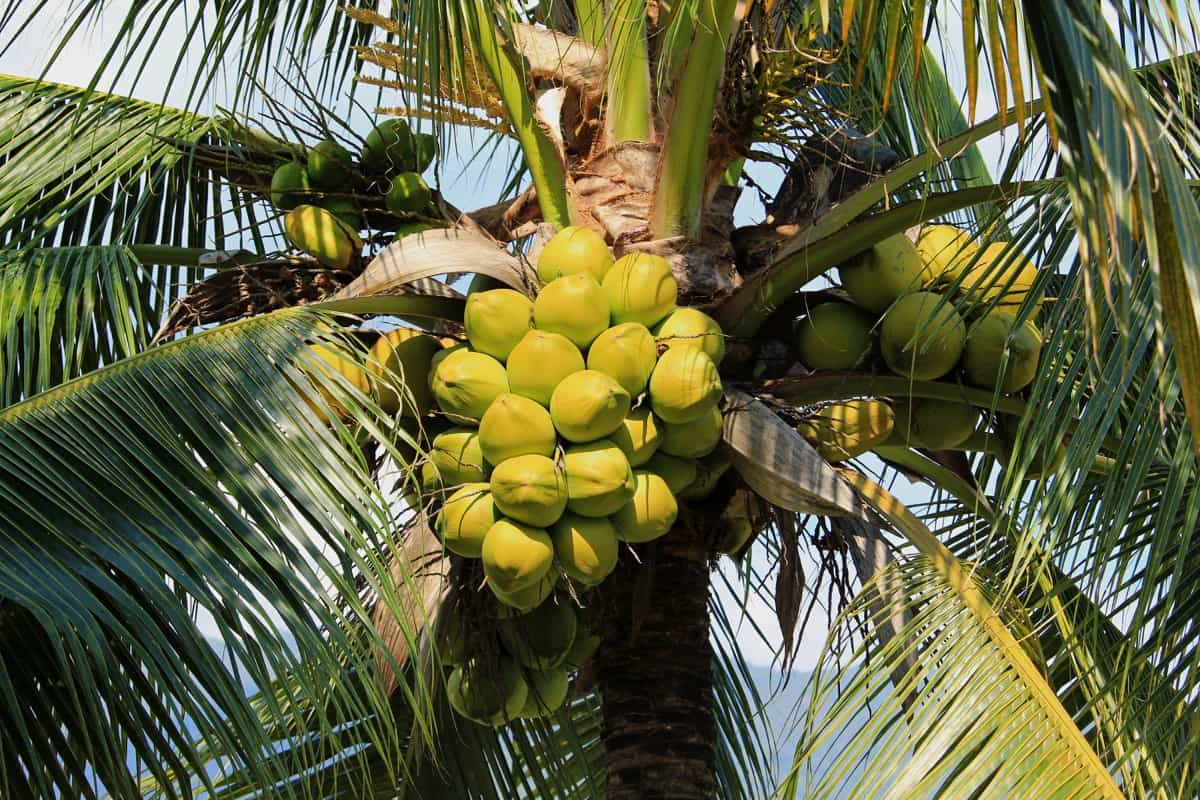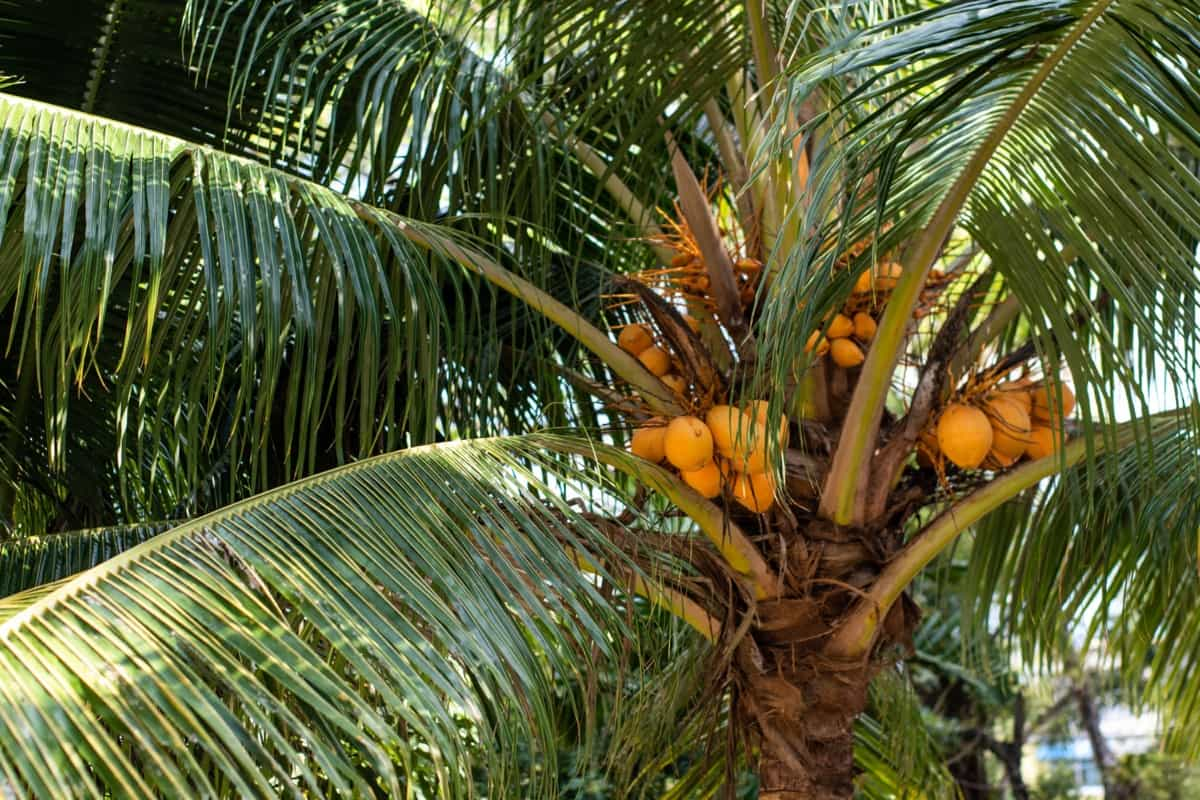Coconut trees are one of the most valuable crops in the world, and their fruit is used for various purposes, such as making oil, milk, and other products. However, these trees are susceptible to various diseases and pests that can cause them to die. This article explains some common causes of dying coconut trees and how to fix them.

9 Causes of Dying Coconut Trees
Why is My Coconut Tree Dying in Summer Heat, and How Can I Save It?
If temperatures rise, the soil dries quickly, and the tree’s roots cannot absorb sufficient water, leading to dehydration. This dehydration can cause the leaves to turn brown and eventually fall off, causing the tree to die. Provide the tree with sufficient water and nutrients. Watering the tree regularly, especially during the morning and evening, can help keep the soil moist and prevent dehydration. Additionally, fertilizing the tree with proper nutrients can help keep it healthy and strong.
Preventing Coconut Tree Death from Fungal Infections: Effective Remedies and Prevention Tips
- Fungal spores can live in dead leaves and other debris. Remove any fallen leaves or fronds from around the tree regularly.
- Over-watering can create a moist environment that is ideal for fungal growth. So, water the tree only when necessary and ensure the soil is well-drained.
- Apply a fungicide to the tree before the rainy season or when there is a high risk of fungal infections.
- Remove any dead or diseased fronds and ensure the tree is properly shaped.
- Plant-resistant varieties of coconut trees. Some varieties of coconut trees are more resistant to fungal infections than others. Choose a variety that is known to be resistant to fungal infections.
Identifying Nutrient Deficiencies in Coconut Trees and Remedies to Revive Them
- Yellowing Leaves: It could be due to a nitrogen deficiency. Apply nitrogen-rich fertilizers such as urea or ammonium sulfate.
- Stunted Growth: It could be due to a phosphorus deficiency. Apply fertilizers that contain phosphorus, such as superphosphate or triple superphosphate.
- Brown Spots on Leaves: It could be due to a potassium deficiency. Apply fertilizers that contain potassium, such as potassium chloride or potassium sulfate.
- Small Coconuts: It could be due to a magnesium deficiency. Magnesium is necessary for the production of chlorophyll and the development of fruits. Apply magnesium-rich fertilizers such as Epsom salt.
How to Protect Coconut Trees from Pests and Diseases to Prevent Decline and Death
These plants are vulnerable to various pests and diseases that can cause accountable damage and even death if left unchecked.
- Coconut mite: To prevent the spread of coconut mites, keeping the tree well-watered and removing any dead or damaged leaves as soon as possible is important.
- Rhinoceros beetle: To prevent infestations of rhinoceros beetles, it is important to keep the area around the tree clean and free of debris, as these insects attract decaying plant matter.
- Lethal yellowing: A bacterial disease causes the tree’s fronds to turn yellow and eventually die. To prevent the spread of disease, it is important to keep the tree well-watered and to avoid planting other susceptible plants nearby.
- Root rot: It is caused by various fungi that thrive in wet conditions. To prevent this, it is important to avoid over-watering the tree and ensure the soil around the tree is well-drained.
Overwatering Issues in Coconut Trees: Signs, Symptoms, and Steps to Rescue a Dying Tree
Overwatering is a common issue that affects coconut trees. When coconut trees are overwatered, they may develop various symptoms, including yellowing leaves, leaf drop, root rot, and stunted growth. Overwatering can lead to oxygen deprivation in the roots, which can cause them to decay and die.
In case you missed it: Coconut Palm Insurance Scheme in India: Coverages and How to Apply

- Improve the drainage of the soil. This can be done by adding sand or gravel to the soil to improve its texture and allow for better drainage.
- Watering the coconut trees carefully is essential to avoid overwatering. Watering the tree deeply once a week is recommended rather than giving it frequent shallow watering.
- Planting coconut trees in well-drained soil is essential to prevent the overwatering issue. Coconut trees prefer well-drained soil rich in organic matter.
Underwatering Issues in Coconut Trees: Signs, Symptoms, and Steps to Rescue a Dying Tree
Underwatering is a common problem for coconut trees, and if left unchecked, it will cause serious damage and even death. The first symptom of underwatering in coconut trees will start to droop and curl, and the tree will look less healthy overall. The leaves may also turn yellow or brown and fall off the tree prematurely.
- Coconut trees require a lot of water, especially during the growing season. The soil around the coconut tree should be kept moist but not waterlogged. Water the tree deeply and infrequently, rather than giving it frequent shallow watering.
- If the tree has already been damaged by underwatering, Pruning the damaged leaves and branches can help the tree recover, as can fertilizing the soil around the tree to encourage new growth. It may also be necessary to support the tree, such as staking or tying it to other trees or structures.
Coconut Tree Winter Damage/dying: Protecting Trees from Frost and Cold Temperatures
Coconut trees die in winter due to the cold temperatures. Coconut trees are adapted to warm and humid conditions, requiring a minimum temperature of 20°C to survive. When the temperature drops below this level, the tree can suffer from cold stress, affecting its growth and development. In severe cases, the tree can die.
- Protect the tree from cold temperatures. This can be done by wrapping the trunk in insulation or covering the tree with a blanket or tarpaulin. Ensuring the covering is not too tight is important, as this can restrict the tree’s growth and cause damage.
- Another way to save a dying coconut tree in winter is to water it regularly. Watering the tree can help regulate the temperature around the roots, protecting the tree from frost damage.
Improper Pruning May Cause Coconut Tree Death: Pruning Methods for Healthy Growth
One of the most common mistakes in pruning coconut trees is cutting off too many fronds at once. This causes stress to the tree and slows down its growth. Another problem is not removing dead or diseased fronds, which can attract pests and diseases.
- One key technique is removing only the dead or dying fronds rather than cutting off healthy ones. This allows the tree to retain its natural appearance and grow healthily.
- It is best to prune coconut trees during the dry season when the tree is less susceptible to infections and pests.
Reviving a Stressed Coconut Tree: Rehabilitation Methods for Overall Recovery
- One of the first steps in rehabilitating a stressed coconut tree is to prune any dead or damaged fronds.
- Fertilizing is another essential step in rehabilitating a stressed coconut tree. A balanced fertilizer with equal percentages of nitrogen, phosphorus, and potassium can help provide essential nutrients for the tree’s recovery.
- Providing adequate water is crucial for the overall recovery of a stressed coconut tree. Watering should be done deeply and regularly, especially during drought or high temperatures.
- In addition to these methods, several other rehabilitation techniques can revive a stressed coconut tree. These include mulching, which helps retain moisture and regulate soil temperature, and applying fungicides or pesticides to prevent or treat disease and pest infestations.
In case you missed it: How to Increase Female Flowers in Coconut: Explained in 10 Steps to Increase Yield and Profit

Conclusion
In conclusion, dying coconut trees can be caused by various factors such as fungal infections, pest infestations, and environmental factors. Identifying the cause of the problem is crucial to fix the issue and save the trees. By implementing proper measures, coconut trees can continue thriving and provide the world with valuable resources.
- Feed Your Flock for Less: Top 10 Tips to Save on Chicken Feed
- Ultimate Guide to Ossabaw Island Hog: Breeding, Raising, Diet, and Care
- Hatching Answers: The Top 10 Reasons Your Chickens Aren’t Laying Eggs
- Eggs and Economics: Breaking Down the Cost of Raising Backyard Chickens
- Defend Your Greens: Proven Methods to Keep Iguanas Out of Your Garden
- Ultimate Guide to Cinnamon Queen Chicken: A Comprehensive Guide for Beginners
- Ultimate Guide to California Tan Chicken: Breeding, Raising, Diet, Egg-Production and Care
- Ultimate Guide to Marsh Daisy Chicken: Breeding, Raising, Diet, and Care
- 10 Types of Chicken Farming Businesses You Can Start for Profits